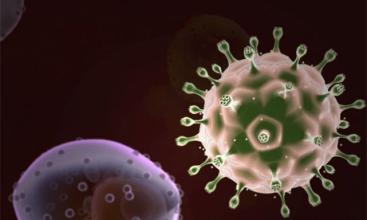据英国媒体报道,美国斯坦佛大学医学院1日发表的一份研究报告显示,艾滋病毒的远古祖先开始在野生灵长类动物体内进化的时间,比人们以前认为的要早好几百万年。 这一发现为人类研究艾滋病毒的起源开辟了一条重要的新途径。艾滋病自1981年被发现以来,已经夺去了2500多万人的生命,而且仍直接威胁着很多人的生命。该发现还有力地支持了这样的科学预言:像艾滋病毒这样的病毒在灵长类和其他野生生物间的存在,比人们以前认为的更加普遍,这种情况给密切接触这些动物的人带来了潜在风险。人们认为非洲的灵长类将两种艾滋病毒变种传播给了人类,科学家对此深信不疑。
斯坦福大学的传染病研究员、这篇论文的第一作者罗伯特·吉福德说:“它为以后的研究指明了方向,今后我们必须确定这些病毒的分布有多广泛。”吉福德和他的同事们研究在马达加斯加岛发现的灰鼠狐猴。这是一种大小跟松鼠差不多,长着圆圆的大眼睛的灵长类。他们发现,他们研究的这种狐猴的基因组携带有过滤性病毒(Lentiviruses),这种病毒跟艾滋病毒属于同一类。自从艾滋病出现以后,科学家就开始认真研究过滤性病毒。
虽然在狐猴体内发现过滤性病毒让这些研究人员感到非常吃惊,但是更让他们感到震惊的事实是,狐猴可能已经携带这种病毒至少1400万年了。这个时期该岛和非洲主大陆之间可能还存在一个大陆桥,因此,其他感染艾滋病毒的生物,才有机会把这种病传染给生活在这座孤岛上,过着与世隔绝的生活的灰鼠狐猴。灰鼠狐猴仅生活在马达加斯加岛上。
而生活在这座小岛以外的狐猴,可能在8500万年前便携带这种病毒了。这个时期包括狐猴在内的灵长类动物开始逐渐分化,演变成猴子、猿和人类。灰鼠狐猴感染这种病毒的另一种途径是,蝙蝠等感染艾滋病毒的哺乳动物飞越非洲大陆和马达加斯加岛之间宽大约是400公里的海面,科学家认为这种情况不太可能发生。
这些发现改变了人们对灵长类携带这种类似艾滋病毒的病毒的时间,以及这些病毒的进化有多么久远的认识。吉福德说:“人们曾普遍认为,这种类似艾滋病毒的病毒的出现时间最多只有100万年。但是有很多人认为该病毒出现的时间更短。”确定生物携带为病原体提供栖息地的过滤性病毒已经有多长时间,可帮助科学家了解它们是如何在野生群体里传播和进化的,以及预防它们的生物学方法。研究发现,狒狒、乌白眉猴(sooty mangabeys)和非洲绿猴等特定灵长类动物携带这些病毒却不会致病。科学家可以利用这方面的知识,避免人类不再感染目前只有野生生物才携带的其他类似艾滋病毒的病毒。它还有助于医学家通过查明这些病毒的特征,研制出可预防艾滋病的药物。这些特征可能对此类病毒发挥正常功能至关重要。这项研究为新艾滋病药物提供了一个全新的攻击目标。现在,人们已经普遍接受了HIV-2变种是由西非的乌白眉猴传染给人类的观点。第一批传播这种病毒的人可能是为了肉食而捕杀野生动物的猎人,或者将这种灵长类动物当作宠物喂养的人。科学家认为HIV-1是由黑猩猩传给人类的。吉福德说:“我们通过这些发现急需确定的问题,是过滤性病毒的分布情况,它们的传播途径,以及它们已经出现多长时间了。”(孝文)
Scientists find HIV ancestors has been in existence for 8,500 years
December 5, 2008 10:17:36 Source: Sina Technology
According to British media reports, the United States Stanford University School of Medicine 1, a study published report shows that HIV at the start of the ancient ancestors of wild primates in the body of the evolution of time than people previously thought to be tens of millions of years earlier. The discovery of human studies of the origin of HIV has opened up an important new ways. Since AIDS was discovered in 1981, has claimed more than 2500 million people, but also directly threatens the lives of many people. The force was also found to support this scientific prediction: such as the HIV virus in primates and other wildlife between the existence of people than previously thought more generally, it gives the animals in close contact with those who bring The potential risks. It was felt that the African primates will be two variants of HIV spread to humans, scientists believe that. Stanford University researcher of infectious diseases, the paper‘s first author Robert Gifford said: "It was after the study pointed out the direction in the future, we must determine how widely distributed the virus." Gifford and his colleagues In the study found that the island of Madagascar lemurs Chinchilla. This is the size of a squirrel with more or less the same length with large round eyes of primates. They found that their study of lemurs that the genome of the virus carrying the filter (Lentiviruses), with the HIV virus in the same category. Since the emergence of AIDS, scientists began to seriously study the viruses. Although the lemur was found in the body so that these viruses are very surprised researchers, but they are even more alarming fact is that the lemur might have to carry the virus for at least a million years 1400. During this period, Africa‘s main island and the mainland may still exist in a continental bridge, the other HIV-infected biological, have a chance to spread the disease to live in the island, living a life of isolation Chinchilla‘s lemurs. Chinchilla only lemurs in Madagascar live on the island. The people living in the island other than the lemurs, in 8500 million years ago may be carrying the virus. During this period, including lemurs and other primates gradually began to pide into monkeys, apes and humans. Chinchilla lemur infected with the virus in another way, bats, and other mammals infected with HIV on the African continent over the island of Madagascar and the width between about 400 km of the sea, scientists believe that this situation is unlikely to occur. These findings changed the way people of primates carry this virus similar to HIV-time, as well as the evolution of these viruses how long. Gifford said: "It was generally agreed that such a virus similar to HIV in the emergence of a maximum of only 100 million years of time. But there are a lot of people think that the virus appears shorter time." Determined to carry biological pathogens provide habitat for the filter How long has the virus and may help scientists understand how they are spread in the wild population, and evolution, as well as their biological prevention methods. The study found that baboons, monkeys zanthopygia Ukraine (sooty mangabeys) and the African green monkey, and other specific primates carry these viruses are not pathogenic. Scientists can use this knowledge to prevent human infection not only wildlife to carry other similar HIV virus. It also helps to identify them through the medical scientist Characteristics of the virus, developed a drug to prevent AIDS. These characteristics of such viruses may play a crucial function of the normal. The study of the new AIDS drug to provide a new target. Now, it has been generally accepted by the HIV-2 is a variant of the Ukraine by the West African monkey zanthopygia transmitted to humans. The first spread of the virus may be to meat and hunters kill wild animals, or primates such as feeding pets. Scientists believe that HIV-1 from chimpanzees to human. Gifford said: "We found an urgent need to identify these issues is the distribution of viruses, their transmission, as well as how long they already had." (Xiao Wen)
 爱华网
爱华网


